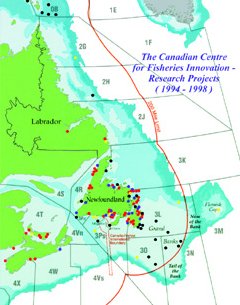Click chart for enlargement
Banner Projects for 1998/1999
|
Future Research Areas
|
Growth Through Innovation
Canadian Centre for Fisheries Innovation
Fisheries research and development continued at a brisk pace in 1998 with industry capitalizing on expanding opportunities. In step with a strong shellfish industry, recovering finfish sector and growing aquaculture industry, the Canadian Centre for Fisheries Innovation (CCFI, a Memorial University-based research organization) joined forces with industry on 30 new projects and concluded several long-term research programs.
Crab
Researchers have been busy in the expanding crab sector. The Fisheries Association of Newfoundland and Labrador, CCFI, the Marine Institute and C-CORE are completing a research program to enhance the flavour of the Newfoundland product and increase productivity. Results include a new leg cutting machine, which boosts yields by 1% to 2% and industry earnings by $1.5 million per year. Engineers have also developed a technological process, still in the prototype stage, that safeguards the natural flavour and appearance of "salad meat" and boosts yields. Other advances include Canpolar East's crab section washer. The machinery, developed with assistance from the Marine Institute and CCFI, generates annual savings to the industry of $1.0 - $1.5 million.
Shrimp
The inshore northern shrimp fishery has developed from the planning stage into a vibrant $100 million industry in the last two years. Shortly after the first shrimp were allocated in April 1997, CCFI hosted workshops focussed on the start-up and successful operation of a shrimp enterprise. More than 300 industry participants attended. Since then, the industry has been keen to take on new harvesting and processing initiatives. For example, in 1998 shrimp harvesters, working with the Marine Institute and CCFI, successfully modified inshore trawls to reduce the amount of the finfish by-catch. The use of the modified trawls is now widespread. Exploratory work on shrimp pots also started.
Finfish
CCFI worked closely with the Groundfish Enterprise Allocation Council to conduct an industry survey of cod in 3Ps. The survey was instrumental in providing information needed for the reopening of the south coast cod fishery in 1998. The reopening gave anxiously waiting groundfish harvesters the chance to fish again and test ideas that had been evolving during the downtime. With assistance from both levels of government, industry members tested the cod farming idea initiated and developed by SeaForest Plantations, CCFI and the Marine Institute earlier in the decade. The experiments were successful and laid the foundation for widespread acceptance of cod ranching as a viable business opportunity. The experiments also identified new areas for further research and development. The fishing industry is aggressively seeking newer and more environmentally friendly ways to fish. In this regard, Fishery Products International, working closely with CCFI and the Marine Institute, has developed and tested new devices and equipment that reduce by-catch and harvest more responsibly. Research on gear selectivity and the move to more environmentally friendly fishing methods are an essential part of the fishery of the future.
Aquaculture
In fish farming, the Province is intensively developing halibut, flounders, cod, mussels, scallops and other cold-water species. A promising species is sea urchin. New Ocean Enterprises of Placentia Bay and E. J. Green's of Trinity Bay, have partnered with CCFI, MUN and the Marine Institute to enhance wild sea urchin. The objectives are to produce top-quality urchin roe that is optimal in size and harvested at a time that is best suited for peak market conditions in the East Asian markets. In other species, companies are investing to diversify and boost revenues. Significant advances in the mussel business and other species are expected in the coming year.

